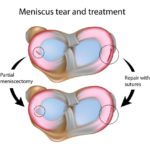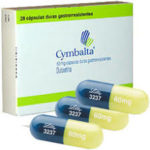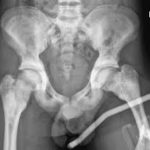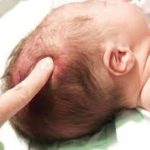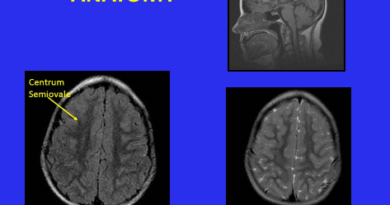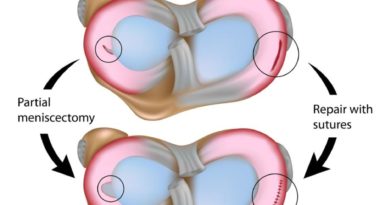Spermatocele
What is Spermatocele?
Spermatocele is a condition where cyst builds up in your epididymis is known as spermatocele. Cyst is a fluid that has sperms. Epididymis is a tube that is joined to your testicles and assists in transporting sperms. Normally, when you have spermatocele, the cysts develop in the epididymis head.
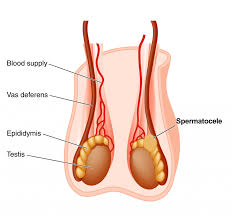
There are various sizes of spermatocele which can be found in the epididymis; they may vary from one to many or develop in one or both of your epididymis.
Spermatocele is mostly found in adult men but this does not lower their fertility. The cysts are not painful and not cancerous.
Epididymis – Location and Function
Epididymis is a stiff tube that is found at back surface of both testicles. The tube is usually coiled to allow its long length of about 20 feet to fit into the small space. The long length of the tube makes it act as storage space for sperms. Also, the length of the tube gives the sperm adequate time to mature.
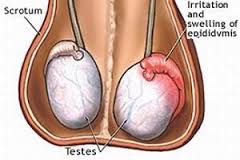
There are three sections of the epididymis and they include the head, the pointed tail, and the body. Another function of the epididymis is that it absorbs fluids and helps add substances that feed and nourish the maturing sperm. Both epididymis directly attach to the respective testicle meaning that if the epididymis is inflicted with an infection, or it is inflamed, the testicle it attaches to will also be inflamed or infected.
Causes
The real causes of spermatocele have not been indentified yet. However, the following are considered as some of its causes:
Blockage of epididymis
Epididymis comprises of vas deferens and epididymi. The epididymi carries sperms from your testes to the vas deferens to ejaculate. When your epididymis is obstructed, you will not be able to ejaculate. There are several causes that may block your epididymis such as:
Infections
Your epididymis may become inflamed through infections leading to a condition known as epididymitis. This condition is as a result of bacteria or sexually transmitted infections. Chlamydia and gonorrhea are most known sexually transmitted infections that affect your urethra system.
The infection from the urethra may also spread to other parts including your testicles and epididymis. Epididymitis affects all men irrespective of age although it is prevalent in men of 14 to 35 years.
Epididymitis may be chronic or acute. Acute epididymitis does not cause swelling in your testes and may last for less than six weeks. When epididymitis is chronic, you will feel pain in the testicles, epididymis and scrotum.
Inherited abnormalities
Obstruction of the epididymis may occur at birth. A child may be born when some parts of the epididymis are missing such as vas deferens. In this circumstance, you will not ejaculate sperms from the epididymi.
Other causes of epididymis obstruction include:
- Injury to your genital tract
- Prostate infections that cause prostate to enlarge.
- Presence of stones in the epididymis
Risk factors
Age has been found as one of the risk factors in men to develop spermatocele. Men between the ages of 20-50 are more vulnerable to spermatocele.
Symptoms
There are no signs and symptoms of spermatocele when they are small. However, when they grow and become big, you will feel pain in the areas of your testicles that have cysts making you unease. You will also feel that your testicles are heavy and areas below or behind your testicles seem to have an accumulation of fluid or solid.
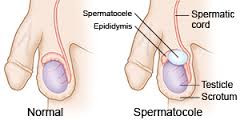
Diagnosis
Spermatocele is diagnosed through a physical examination of your scrotum conducted by your doctor. Your doctor will direct light to each side of your testicles to find out which type of mass is present.
For a solid mass, the light will not penetrate it and if it contains fluids the light will pass through. In case, this method is unable to reveal the cause of spermatocele; your doctor may use ultrasound imaging test to find the cause of the cysts.
Ultrasound imaging test uses high frequency sound waves to produce detailed images of your testicles and scrotum. These pictures are then analyzed to disqualify presence of a tumor in your testicles and other causes.
Treatment
Few spermatoceles require treatment, especially those that are painful and enlarged. If you have a severe and large spermatocele, your doctor will prescribe medications to relieve pain such as ibuprofen.
If the cause of your spermatocele is epididymitis, your doctor will prescribe antibiotics to treat it.
Surgery
Your doctor may also decide to surgically remove the spermatoceles. The surgical procedure your doctor will perform is known as spermatocelectomy. In this procedure, your doctor may conduct it away from the hospital and there is no need for you to be admitted.
The doctor makes an incision through your scrotum while you are under a general anesthesia and dissects your spermatoceles and separates it from the epididymis.
Your doctor may offer you a supporter to wear in order to protect the area of incision from damage after surgery. This procedure may cause swelling and pain at the site of incision, your doctor may recommend medications to reduce pain as well as advice you to use ice packs to relieve swelling.
One of the complications, although rare, that may occur during spermatocelectomy is damaging your epididymis. Damage to your epididymis may make you infertile because transport of sperms will be impossible.
Aspiration
Another procedure that your doctor can use to treat spermatocele is aspiration. In this procedure, your doctor inserts a needle into your spermatocele and drains out the fluid.
How do You Check your Testicles?
One of the best measures to detect any changes in your testicles is to self -check your scrotum once a month. You can consult your doctor to advise you on the best way to examine your testicles.
You can examine your testicles in the bathroom after having a warm shower. Warm water releases heat that helps to calm down your scrotum so that you can easily notice any abnormal thing there. While in the shower, do the following:
Step 1
Make sure you are standing in front of the mirror. Then observe the scrotum skin for any enlargement.
Step 2
Check each of your testicles by placing the middle and index fingers below the testicles while the thumb is on top. Roll the testicles gently between your fingers and thumbs and feel any changes on the surface of the testicles. Normally your testicles are firm, smooth and oval in shape as well as one testicle may be larger than the other one.
Examine your testicles regularly so that you are able to understand changes that may be of worry. If you notice unusual swellings on your testicles, call your health provider immediately.
This examination of your testicles is very crucial but it should not replace a visit to the hospital for checkup.
Reference List
- Epididymitis. Available at http://www.healthline.com/health/epididymitis#overview1
- Spermatocele. Available at http://www.mayoclinic.org/diseases-conditions/spermatocele/basics/prevention/con-20024190
- Spermatocele (Epididymal Cyst). Available at http://www.webmd.com/men/tc/spermatocele-epididymal-cyst-topic-overview
- Spermatocele. Available at http://www.healthcentral.com/encyclopedia/hc/spermatocele-3168668/
- Spermatocele. Available at https://my.clevelandclinic.org/health/articles/spermatocele

